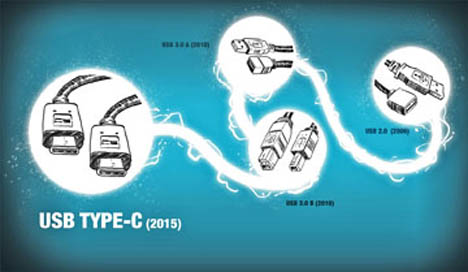As I was driving to work the other day, my phone gave me an ominous “beep-beep.” The screen indicator showed that my phone would soon be going into sleep-mode because of a low battery. Quickly, I reached for my charging cable and fumbled with connecting my phone over USB, hoping to see the familiar lightning bolt on the screen. After a few moments of fumbling with the connector, I decided to focus on the more important task of driving. A sense of panic hit me as the day had just begun, and my tethered connection to the outside world would soon come to an end. I’m certainly not the only person who has experienced this, but the good news is we won’t have to for much longer – all hail USB Type-C.
The introduction of USB Type-C, the next-generation USB connector, is a great standardization undertaking the industry is moving toward. By successfully merging USB data, up to 100 W of power, and uncompressed video content over alternate-mode connections (such as DisplayPort) – USB will truly be the “universal” connection between our tablets, laptops and mobile devices – and that is just the beginning of what the standard can achieve.
A universal solution
Did I mention that there is no “wrong” way to plug in the cable? A USB Type-C cable can be connected whether upside down or downside up because the connections look and fit together exactly the same way on both ends of the cable. This creates one standard connector for all USB protocols – no more Type-A, Type-B, micro USB2.0, micro USB3.0 or mini-USBs (Figure 1).

Figure 1. The evolution of USB beginning in the year 2000.
In addition to shear convenience, this approach will also help our electronics to continue to get smaller. The USB Type-C port is packaged in a smaller size – about the size of today’s micro-USB connections. This will allow laptops and smartphones to become even thinner because they don’t have to accommodate the traditional larger-sized USB Type-A ports. This means fewer cables and cords complicating our lives, with just one, smaller and faster connection – with greater than 20 Gbits/s data rate.
This connector will change the face of personal electronics, along with how and when we use our digital products. As such, Texas Instruments has invested considerable effort in being part of this successful journey. There are a number of companies making chip to make Type-C easy to implement.
For customers wanting to quickly migrate their existing USB mobile products, the TUSB32x family from Texas Instruments offers the smallest footprint and the lowest power. This device provides full configuration channel (CC) logic and port control to support USB 2.0/3.x products. For fully-featured implementations, the TPS65982 controller features highly integrated USB power delivery (PD) with alternate-mode support. This device can be augmented with the HD3SS460 USB Type-C high-performance cross-point switch, which boasts of having the lowest power in both active and standby modes.
It won’t be long before these products are in the latest electronics and computers. Soon, we can say goodbye to our power cords, dongles and adapters. The day of one cable for nearly every electronic need has arrived. Now we can easily plug in our phones no matter where we are and it just works – all for one, and one connection for all!
Advertisement
Learn more about Texas Instruments





